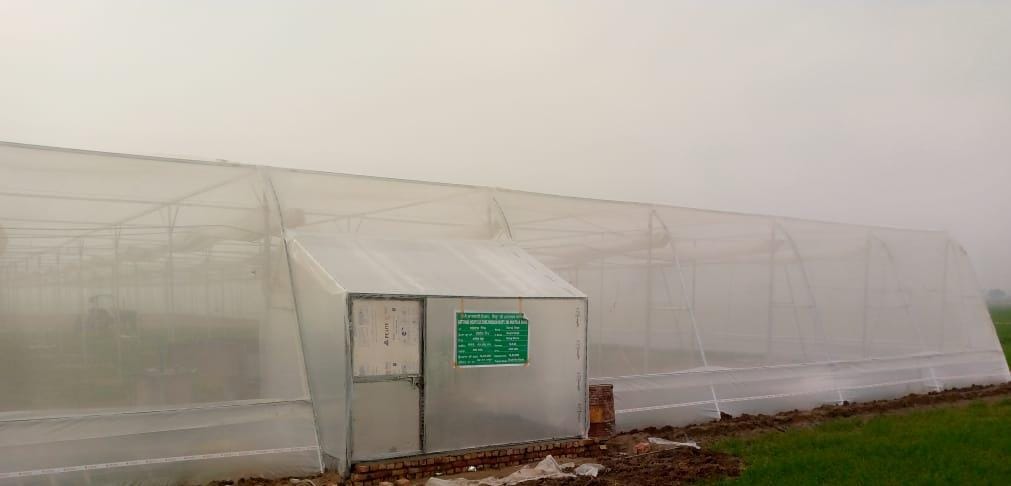Shade Type House Model: Flat
Innovative in its simplicity yet profound in its impact, the flat type shade house model represents a versatile approach to agricultural shading solutions. Designed to provide protective cover while optimizing natural environmental conditions, this model is particularly suitable for regions where moderate shading and climate control are essential for successful crop cultivation. Let’s delve into the features, benefits, and practical applications of the flat type shade house model in agricultural settings.
Features:
- Structure and Design: The flat type shade house model features a straightforward design with a flat roof structure supported by columns or poles. The roof is typically covered with shade netting or woven fabric materials that offer varying degrees of shading (e.g., 30%, 50%, or 70% shading intensity). This design allows for ample headroom and easy maneuverability inside the structure.
- Shade Netting Options: Shade netting used in flat type shade houses is selected based on the specific light transmission requirements of crops. It helps to diffuse sunlight, reduce heat stress, and protect plants from excessive sunlight exposure. Different shade percentages cater to different crop needs and climatic conditions, providing flexibility in managing light intensity.
- Natural Ventilation: While providing shading, the open design of flat type shade houses promotes natural ventilation. Open sides or adjustable vents allow for airflow, helping to regulate temperature and humidity levels inside the structure. This enhances air circulation around plants, reducing the risk of diseases and promoting healthier growth.
- Modular Construction: The modular construction of flat type shade houses facilitates easy assembly, disassembly, and relocation. This scalability allows farmers to adjust the size and layout of the structure according to crop requirements or operational needs. It also supports efficient land use and management practices.
- Durability and Maintenance: Built with durable materials such as galvanized steel, aluminum, or treated timber for the framework, and UV-stabilized shade netting or fabric for the cover, flat type shade houses are designed for longevity and minimal maintenance. They withstand outdoor conditions while providing reliable protection to crops throughout the growing season.
Benefits:
- Crop Protection: The primary benefit of flat type shade houses is crop protection from harsh environmental conditions such as excessive sunlight, wind, and hail. The shading provided by the structure helps to create a more favorable microclimate, reducing heat stress on plants and minimizing sunburn damage.
- Temperature and Humidity Control: By moderating temperature and humidity levels, flat type shade houses create a stable growing environment. This is beneficial for sensitive crops and those susceptible to temperature fluctuations, ensuring optimal conditions for growth and development.
- Water Conservation: Shade houses reduce water evaporation from the soil surface and help maintain soil moisture levels. This contributes to water conservation efforts and supports efficient irrigation practices, especially in arid or semi-arid regions.
- Pest and Disease Management: The protective cover of shade houses acts as a physical barrier against pests and airborne diseases. Combined with good ventilation, this reduces the need for chemical pesticides and fungicides, promoting integrated pest management (IPM) practices and enhancing crop health.
- Versatility and Adaptability: Flat type shade houses are versatile structures suitable for a wide range of crops, including vegetables, flowers, and nursery plants. They can be used in both open-field settings and semi-protected environments, offering flexibility in crop selection and cultivation practices.
TECHNICAL SPECIFICATIONS
| Product Name | Naturally Ventilated Polyhouses |
| Roof Type | Flat Roof |
| Available Size | 500m2/1000m2 / 2000m2 / 4000m2 |
| Grid | 8m x 4m, 8m x 6m |
| Side / Center Height | 4.0m / 4.0m, 5.0m/5.0m, 5.8m/5.8m |
| Hockey | 2.0m, 2.5m, 3.0m, 3.5m |
| Side covering | Insect Net, 110 GSM, Mono x Mono net with Apron 140GSM |
| Side Ventilation | 3.5 M to 4.0 M |
| Side covering | Insect net, 110 GSM with Apron Sheet |
| Top Covering | Mono x Mono net 100 to 125 GSM or insect net 110 GSM |
| Second layer | Inside Sliding Net Cover with 50% Shed Net Mono. |
| Trellising System | 8mm, 4mm Rope wire with 3mm Plastic wire or 3mm G.I wire |
| Drip Irrigation | Inline drip irrigation system, fogging System |


